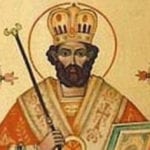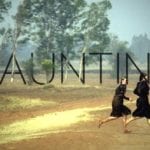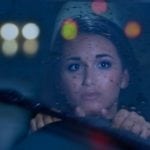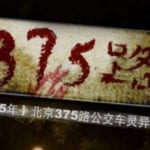 Animals
Animals  Animals
Animals  Weird Stuff
Weird Stuff 10 Weird Things People Used to Do at New Year’s
 Our World
Our World 10 Archaeological Discoveries of 2025 That Refined History
 Weird Stuff
Weird Stuff 10 Fascinating Facts You Might Not Know About Snow
 Miscellaneous
Miscellaneous Top 10 Things Crypto Was Supposed to Change & What Actually Did
 History
History 10 Huge Historical Events That Happened on Christmas Eve
 Music
Music 10 Surprising Origin Stories of Your Favorite Holiday Songs
 History
History 10 Less Than Jolly Events That Occurred on December 25
 Weird Stuff
Weird Stuff 10 Funny Ways That Researchers Overthink Christmas
 Politics
Politics 10 Political Scandals That Sent Crowds Into the Streets
 Animals
Animals 10 Species That Refused to Go Extinct
 Weird Stuff
Weird Stuff 10 Weird Things People Used to Do at New Year’s
 Our World
Our World 10 Archaeological Discoveries of 2025 That Refined History
Who's Behind Listverse?

Jamie Frater
Head Editor
Jamie founded Listverse due to an insatiable desire to share fascinating, obscure, and bizarre facts. He has been a guest speaker on numerous national radio and television stations and is a five time published author.
More About Us Weird Stuff
Weird Stuff 10 Fascinating Facts You Might Not Know About Snow
 Miscellaneous
Miscellaneous Top 10 Things Crypto Was Supposed to Change & What Actually Did
 History
History 10 Huge Historical Events That Happened on Christmas Eve
 Music
Music 10 Surprising Origin Stories of Your Favorite Holiday Songs
 History
History 10 Less Than Jolly Events That Occurred on December 25
 Weird Stuff
Weird Stuff 10 Funny Ways That Researchers Overthink Christmas
 Politics
Politics 10 Political Scandals That Sent Crowds Into the Streets
10 Ghosts And Legends Of The Ohio River Valley
The areas around the Ohio River, a tributary of the more famous Mississippi River, have been home to their share of spectacular legends. Once the gateway to the American West, the Ohio River Valley is better known today for economically vital cities like Pittsburgh and Louisville as well as pockets of rural and Rust Belt poverty. However, from graveyard ghouls to ancient prophecies, the towns and cities that dot the Ohio River Valley are awash in stories and campfire tales.
10 Kentucky Lizard Man

The tiny town of Stephensport, Kentucky, sits on the Ohio River facing the border with Indiana. You wouldn’t expect much excitement there, but something truly odd occurred in autumn 1966. At around 1:30 AM, a Stephensport resident was awakened suddenly by strange sounds outside his home.
As he looked outside through a window, the homeowner reportedly saw a 180-centimeter (6 ft) tall “lizard man” with brownish-green skin, webbed appendages, and a large ridge that ran from his forehead to the crown of his head, where it peaked like an arrowhead. Realizing that someone was staring at him, the creature retreated toward Sinking Creek, which connects to the Ohio River.
This was not the first sighting of a strange reptilian near the Ohio River, and it would not be the last. In 1878, a journalist for The Courier-Journal of Louisville filed a story about the “Wild Man of the Woods,” a 180-centimeter (6 ft) tall humanoid with scales that was captured and displayed in Louisville.
Before that, William Branham, a wild-eyed Kentucky preacher, claimed that the Garden of Eden had not been plagued by a serpent but by a lizard man who had been sent to Earth. Whether or not subsequent sightings of a 5-meter-long (15 ft) lizard man in Trimble County or the 1955 attack on Mrs. Darwin Johnson of Henderson are related to Branham’s creature is anyone’s guess.
Some people believe that the lizard men of the Ohio River are connected with similar creatures like the Loveland Frog of Ohio or the Scape Ore Swamp creature of South Carolina. Mary Burlington, a paranormal researcher active during the 1990s, even claimed that the lizard men of Kentucky are part of an ancient Egyptian lizard cult that existed in Kentucky during prehistory.
9 The East End Ghouls
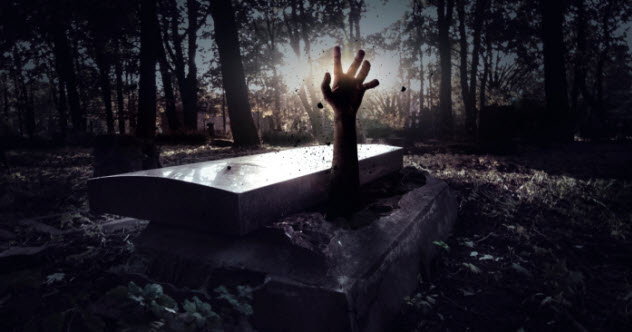
Historic Parkersburg, West Virginia, is best remembered today for the Blennerhassett Island plot, in which Aaron Burr and wealthy Parkersburg patrician Harman Blennerhassett were accused by President Thomas Jefferson of conspiring to create a private empire west of the Ohio River. Many claim that Blennerhassett Island is haunted because of all this intrigue and many deaths.
One of the strangest stories about Parkersburg involves the ghouls that supposedly haunt Holliday Cemetery in the city’s East End. According to legend, strange occurrences began because 19th-century Parkersburg was a terminus for the all-important Baltimore and Ohio Railroad (B&O). This made Parkersburg a bustling hub for businessmen and owners, who came and went with trainloads of the state’s coal. Many stayed the night at the Rowland Boarding House, which was also in the city’s East End.
Not long after midnight one day in June 1888, railroad workers were heading toward the Rowland Boarding House when they were approached by what they claimed was a 180-centimeter-tall (6 ft) apparition covered in a white funeral shroud. Emitting a deep, nonhuman groan, the creature glided toward the men over the B&O tracks until it reached the Rowland house and disappeared. When this story was published in the local papers, a man named Mr. Crolley, who worked for the Camden Consolidated Oil Company, decided to see if the story was true.
For two nights, Mr. Crolley stalked the ghoul. On the first night, the ghoul chased Mr. Crolley all the way to the Rowland Boarding House, where it paused before turning back toward Holliday Cemetery. On the second night, Mr. Crolley watched in horror as the ghoul was joined by another apparition dressed in black. Again, the ghouls made for the boarding house before disappearing at the cemetery.
The East End ghouls haven’t been seen since 1888. But these two apparitions, which supposedly stank of death and decay, remain fixtures of Parkersburg lore.
8 Blue Mist Road

The largest city in the Ohio River Valley, Pittsburgh is the cultural and economic center of Greater Appalachia. Once one of the largest cities in the US, Pittsburgh has managed to reverse the economic decline it experienced in the 1970s and ’80s, becoming the six-time champion of the “Most Livable Cities” list.
Despite its bright present and potentially brighter future, Pittsburgh is not without its haunted history. In the city’s North Park area, an entire road—locally called the “Blue Mist Road”—is reportedly haunted by everything from the spirits of the KKK and their victims to a witch. Either way, the stories about the road’s peculiar character are always the same.
According to the legend, if you find yourself anywhere between Babcock Boulevard and Route 910 at night, a low mist or fog will gather that creates a blue hue if headlights or a flashlight are pointed in its direction. In particular, Irwin Road has been the source of many of these stories, with some even claiming that the fog can take on threatening shapes.
7 Willard Library Ghost
Built in 1885, Evansville’s Willard Library is the oldest public library in Indiana. It is also the first library to install a “ghost cam” due to the recurring appearance of “The Grey Lady,” an apparition first seen in 1937.
For 78 years, librarians and patrons have claimed to see the ghost. Wearing a gray veil, the ghost has been seen at all hours of the day and night throughout the library. However, the Grey Lady seems to prefer the children’s department, which is housed in the basement of the library.
Even when she’s not seen, the ghost is said to pull books off shelves or manifest as cold spots that shift throughout the library. On one occasion, police responding to a burglar alarm supposedly saw a woman dressed in gray smiling at them from an upstairs window.
When the Evansville Courier & Press finally decided to set up cameras in the library, the pictures and videos produced by these ghost cams became so wildly successful that an entire website was established to show all the footage. With all this publicity, the Willard Library has become a popular destination for ghost tourists. In fact, on April 19, 2006, the television show Ghost Hunters aired an episode about an investigation held at the library.
6 Anna Bixby’s Cave
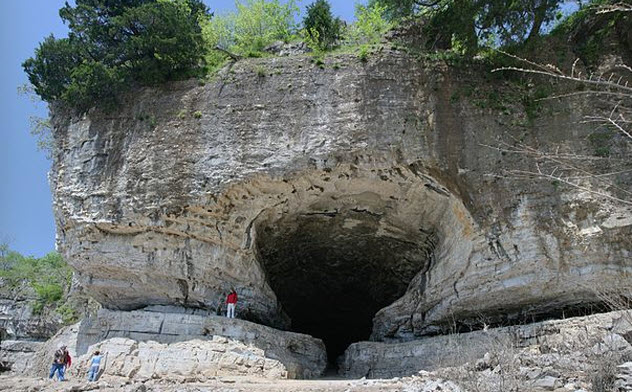
Cave-In-Rock, Illinois, could probably win the “Best-Named Town in America” award if such a thing existed. This southern Illinois town on the Ohio River is known for Anna Bixby—a historical person with so many legends attached to her name that it’s often hard to separate fact from fiction.
What is commonly accepted is that Anna Bixby was a doctor and midwife who treated the sick and wounded throughout southeastern Illinois. She is also regarded as the person who found a cure for “milk sickness,” an illness caused by consuming milk or other dairy products from a cow that has eaten white snakeroot.
While not a trained doctor, Bixby used her knowledge of herbs and natural remedies in her practice. For a time, she was a successful, popular healer among pioneers. But when a major outbreak of an unknown disease began killing people and livestock, Bixby could not find a solution.
As the deaths mounted, many began to suspect that a witch was poisoning their families and herds. That’s when Bixby first suspected that tainted milk was causing the illness, leading her to discover a cure for milk sickness. Unfortunately, Anna could not save her first husband, who died of pneumonia.
Eson Bixby, Anna’s second husband, was a thief who was only interested in Anna’s large fortune. One night while Anna was out seeing a patient, Eson and some fellow criminals captured Anna, put her in chains, threw her from a cliff, and set fire to the woods. Miraculously, a rain came and put out the fire, leaving Anna—who had become caught in some tree branches—with the ability to escape.
According to legend, Anna made her way into a nearby cave to hide her gold and silver. Today, this cave is called “Bixby Cave,” and many have tried to find Anna’s hidden fortune inside.
5 The Ghost Of Jessie Davis Lindsay
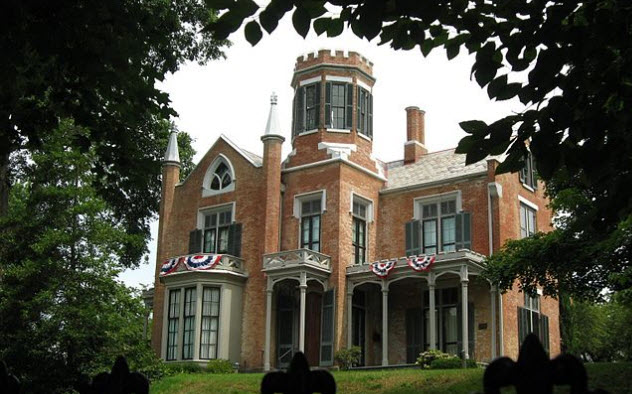
A large home built in the Gothic Revival style, The Castle in Marietta, Ohio, has become a local landmark known for hosting the “Traditions of Halloween” event that details The Castle’s many strange occurrences. The home was originally built in 1855 by abolitionist attorney Melvin C. Clarke, who only lived there for three years. At that point, he sold the property to John Newton, a businessman connected to the Marietta Bucket Factory. Newton turned the estate into a grand spot for entertainment and personal pleasure. When he died in 1886, the property was sold to newspaper publisher E.W. Nye for $7,000.
Eventually, the house was inherited by Nye’s unmarried granddaughter, Jessie Davis Lindsay, who was 55 and slowly becoming a recluse. Many years later, the city of Marietta took ownership of The Castle as a historic landmark, turning it into a public attraction in 1994.
But disturbing reports began to filter out about ghostly activity inside the house. Mysterious temperature drops, doors closing and locking by themselves, and the sounds of disembodied voices all figured into eyewitness accounts. Many people believe that The Castle’s ghost is none other than Jessie Lindsay, the old spinster whom gossip has labeled a witch.
4 The Brandenburg Stone

Some people believe that North American contact with Europe predates Christopher Columbus. For example, they believe that the Viking settlement at L’Anse aux Meadows in Newfoundland is proof that Europeans could have navigated the Atlantic earlier to settle in North America. Other amateur historians and conspiracy theorists also suggest that things like the Bat Creek Stone of Tennessee highlight unrecorded American history that shouldn’t be ignored.
Discovered by a simple farmer over 100 years ago in Brandenburg, Kentucky, the Brandenburg Stone is supposedly a stone map written in a type of ancient Welsh script that was commonly used by the Druids. When translated by Alan Wilson, a specialist in the coelbren script of Wales, the writing on the stone apparently said: “Towards strength [to promote unity], divide the land; we are spread over purely [justly] between offspring in wisdom.”
With its reported use of an ancient Welsh alphabet, the Brandenburg Stone plays a central part in the theory that a Welsh prince named Madoc traveled to North America in the 12th century to flee a fratricide attempt. While it may be easy to laugh off these beliefs as pseudoscience, the stone’s writing has been verified as Welsh by three historians, two of whom were from Cardiff.
3 Ohio River Ghost Ship
About 40 kilometers (25 mi) downstream from Cincinnati, a 110-year-old abandoned luxury yacht sits as a decayed hulk. Officially named the Celt, the ship was commissioned by wealthy railroad owner J. Rogers Maxwell in Wilmington, Delaware. The Celt set sail in 1902 as a 55-meter-long (180 ft) steamship.
When World War I began, the Celt was purchased by the US Navy, renamed the USS Sachem, and outfitted with depth charges and machine guns. From there, the ship changed hands numerous times and was renamed the USS Phenakite during World War II, the Sightseer, and Circle Line V. One legend states that Thomas Edison was given the ship to perform experiments in oceanic communication in the Caribbean.
Somehow, this illustrious history did not stop the ship from falling into disrepair. During the 1980s, the ship vanished. Decades later, it was recovered as a rusted hulk that was partially sunk in Kentucky’s Taylor Creek, a tributary of the Ohio River. Today, kayakers and tourists have made a sport out of trying to find the ship. Due to its rotting exterior and the mystery surrounding its disappearance and rediscovery, the Celt has been rebranded a ghost ship.
2 Edgar Cayce And The Mound Builders

Edgar Cayce gained famed in the early 20th century as a clairvoyant. While his prophecies and readings touched on everything from world finances to the lost civilization of Atlantis, 68 of his self-induced trances involved America’s prehistory. In particular, Cayce claimed that the Mound Builders of the Ohio River Valley dated to as early as 3000 BC and had migrated northward from Mu, an Atlantis-like civilization around Central America.
Without question, the grave mounds that dot the Ohio River Valley are ancient. The largest mound is the Grave Creek Mound just outside of Moundsville, West Virginia (which is also home to the supposedly haunted West Virginia State Penitentiary).
According to archaeologists, the Grave Creek Mound—which is made up of 60,000 tons of earth—was built about 2,000 years ago by the Adena culture. In the same area, the Adena also constructed the ceremonial Great Serpent Mound to look like a giant snake.
For Cayce, the mounds and the Mound Builders were remnants of ancient Atlantis in America. Cayce believed that the Mound Builders had intermarried with members of the local Iroquois tribe, who had then made contact with Scandinavian settlements along the East Coast.
Although Cayce’s ideas aren’t taken seriously by many people, the mounds still have an air of mystery because we know so little about the cultures that built them. All we know for sure is that the Mound Builders were hunter-gatherers who had extensive trading networks and participated in ceremonial burials that differed by social class.
1 The Cornstalk Curse

During the 18th century, the Ohio River Valley was a contested area between the British, the American colonial settlers, and the Native American tribes that lived in the region. Chief Cornstalk was a Shawnee tribal chief who began leading war parties against settlers in 1763. In response, the settlers raided Cornstalk’s village and took him hostage. From there, Cornstalk and some of his men were transferred to Fort Pitt in what is now Pittsburgh. The next year, Cornstalk escaped.
By the 1770s, a large confederation of tribes (Shawnee, Mingo, Miami, Ottawa, Illinois, Delaware, and Wyandot) formed a 1,200-man line that stretched from the Ohio River to the Kanawha River in modern West Virginia. On October 10, 1774, 1,100 militiamen defeated the tribal confederacy led by Cornstalk in the Battle of Point Pleasant. Many historians consider this the first conflict of the American Revolution, although others see it as one of the most decisive victories in the history of westward expansion.
Following his defeat, Cornstalk decided to make peace with the American settlers. In 1777, Cornstalk and Red Hawk, a Delaware leader, traveled to Fort Randolph in Point Pleasant to warn the settlers that a large tribal army was preparing to attack the fort under British orders.
When Cornstalk told Captain Arbuckle, the fort’s commander, that he would let his Shawnee men fight if the other tribes engaged the colonists, Cornstalk, Red Hawk, and other leaders were taken hostage. The men of Fort Randolph thought that holding Cornstalk would keep the tribal army from attacking. It worked for a time.
On November 10, gunshots were heard coming from the Kanawha River. Two settlers had been ambushed by a Native American raiding party. One man was killed while the other escaped. Enraged, some Fort Randolph men disregarded Arbuckle’s orders and shot Cornstalk, Red Hawk, and Ellinipisco, Cornstalk’s son. Before dying from eight gunshot wounds, Cornstalk supposedly cursed the men of Fort Randolph with the Great Spirit’s wrath.
Various disasters in and around Point Pleasant have been blamed on Cornstalk’s curse. The most infamous episode happened in 1967 when the collapse of the Silver Bridge in Point Pleasant killed 46. This disaster supposedly links the legendary Mothman with the curse, connecting two of the largest legends in West Virginia history.
Benjamin Welton is a freelance writer based in Boston. His work has appeared in The Atlantic, The Weekly Standard, Listverse, Metal Injection, and others. He currently blogs at literarytrebuchet.blogspot.com.

